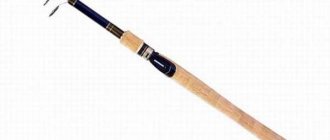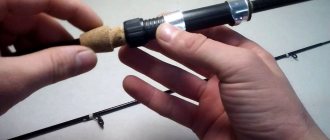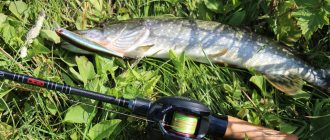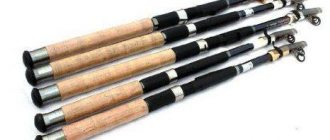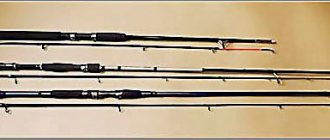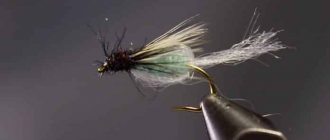Spinning fishing is one of the most respected and popular types of fishing. And this is natural: it gives a range of vivid impressions from a head-to-head fight with a predator, a rush of adrenaline, and a lot of positive emotions. A properly equipped spinning rod and optimally selected bait are important, but do not negate the fisherman’s mandatory possession of basic skills. Mastering the basics of the technique is not so difficult: you can learn how to cast a spinning rod correctly and carry out basic retrieves within one or two trips to a pond.
Our publication today is aimed primarily at beginners who are just starting to dive into the fascinating world of spinning fishing. Our goal is to tell you about casting techniques practiced in various conditions. We will give you a serious theoretical basis, and you will gain practice during trips to the reservoir. It is advisable that an experienced master take the patronage of a beginner, but if one is not available, you can bring the movements to automatism on your own.
The importance of proper technique
Spinning fishing consists of several components: delivery of a wobbler, spinner or silicone to the fishing area, retrieving, hooking, and fishing. Over the course of several hours of fishing, a spinning angler makes dozens or even hundreds of casts. Each of them is a small test of endurance, accuracy and skill.
This bait provides a rich catch even with a bad bite!
More details Many points depend on the correctness of the technique:
- casting distance;
- targeting of bait delivery;
- wear rate of the cord and integrity of the gear;
- avoiding getting caught in nearby bushes and other obstacles;
- degree of fatigue and safety of the fisherman.
Casting is carried out by a sharp swing of the spinning rod in the chosen direction of flight of the bait. At the same time, not only the hands work, but also the body of the fisherman, and some spinning anglers even take a step or two forward, especially when delivering heavy wobblers and spinners over long distances. In this case, the bait hangs 20-50 cm from the “tulip” of the form. You should make sure that the line handle is open, otherwise there is a high probability of the gear breaking.
The spinning rod is thrown with one or two hands (depending on the class of tackle and the individual preferences of the fisherman) with a strong swing, without fixing at individual points of the trajectory. The fishing line is clamped with a finger, and at the end of the throwing phase the fixation is loosened. This moment, if the fisherman acts incorrectly, can result in a reduction in the bait’s flight range, and in some cases, even serious injuries to the hand.
From behind the shoulders, with one or two hands
The shoulder cast technique is used in a narrow spot or cramped area chosen for fishing. With one hand you need to hold the end of the spinning rod handle, with the other you need to stay near the reel. It is located above the shoulder, and the rod occupies an almost vertical position (the tip is tilted behind the fisherman’s shoulders). Now we deflect the tip lower to the ground and with a sharp movement make a jerk forward. While the rod is directly overhead, you need to release the spool so that the bait is in free flight.
From behind your shoulders you can throw the spinning rod with both hands. It will turn out to be much more powerful, but it will also require more effort from the fisherman. It also applies if the tackle you choose is large or two-handed. In such cases, everything should be thought out to the smallest detail. After all, a good, truly long-distance cast can be hampered, for example, by too light a bait or small throughput rings.
Preparing the spinning rod
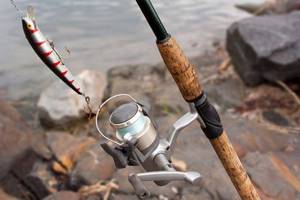
Previously, fishing with spinning tackle was a very labor-intensive task. The rods were equipped with classic inertial reels, and long-distance casting, retrieving, and retrieving were much more difficult for anglers. Line “beards” were common even among masters.
With the invention of the spinning reel, spinning fishing moved to a qualitatively new level: the whole process was significantly simplified. Yes, the weight of a spinning reel is usually higher than the weight of a classic reel, but with equal effort, the angler gets a greater landing range and precision, minimizing the load on the hands, and reducing the risk of beard formation.
We recommend choosing high-quality spinning reels that are characterized by proper line laying: chaotic winding negatively affects the quality of casting. The spool should be filled with line or cord up to the side.
The longer the spinning rod, the further it can be thrown, but the more difficult it is to handle, therefore, it is not recommended for beginners to choose too long forms (from 2.7 m). “Slow” rods provide greater “range” than “fast” ones, but a lot depends on the skill of the fisherman. You should also pay attention to the quality of the passage rings: they must be wide enough, located in one line, without burrs or other defects.
When choosing a fishing line (cord), it is recommended to adhere to the characteristics of the form specified by the manufacturer. Any departure beyond their limits negatively affects the comfort of handling the tackle, as well as its durability.
How to cast a spinning rod correctly
Nowadays, equipping a fishing rod with a spinning reel is a classic option for spinning fishing. Therefore, we will understand the throwing technique more thoroughly by working through the algorithm of the fisherman’s actions. Holding the line on the tackle form with your finger, while lowering the bait thirty centimeters from the tip of the rod, open the line handle. When retracting the spinning rod to the starting point of the swing, the swing point in relation to the angler will be located based on the angler’s choice of the type of casting required at the moment, you should pay attention to the tip of the rod and the hanging line with the bait.
The cord should be in the last ring of the whip, but in no way on the blank. Then a swing is made with a synchronized release of the fishing line when the bait comes in line with the rod blank. In practice, the flight of the bait and the position of the blank, when stopping after the swing, are a directed vector. When the bait is in the water, the line holder is closed. It is advisable to close it manually, and not by turning the reel handle, so the reel will last much longer without being subjected to unnecessary and unjustified loads.
After closing the line holder, the casting is considered completed and you can begin retrieving. Carrying out the sequence of these manipulations fully solves the question of how to properly cast a spinning rod with a spinning reel.
Basic throwing methods
Many experienced fishermen, even if they really want to, will not be able to explain exactly how they cast: it’s one thing to do it, another thing to describe it in words. This action is brought to automaticity and is controlled at the subconscious level. Moreover: the same technique looks slightly different when performed by different anglers.
We will focus on the most popular techniques, but it is not necessary to master all of them at the initial stage. A novice spinning caster can focus on the two main types of casting, vertical and horizontal, bring them to automaticity, and then, if necessary, begin to master refinements such as a pendulum or catapult.
It is believed that light class rods (lights and ultralights) are operated with one hand, while heavy blanks require the use of both upper limbs. However, in practice, many anglers constantly use both hands, regardless of the class of the rod.
Vertical classic

Vertical casting is considered a classic option. It is not too complicated to implement and demonstrates high accuracy and range of bait delivery. In the absence of external obstacles, all anglers use it with minor adjustments.
Let us describe the basic technique in as much detail as possible:
- We provide an overhang of the bait of 25-35 cm (depending on its class, distance, and individual preferences of the fisherman).
- We open the line handler and quickly check the quality of the winding and the absence of beards.
- We take the spinning rod with our working hand so that the leg of the reel seat is between the index and ring fingers.
- Lightly fix the line with your index finger. At the initial stages, you can use gloves to avoid injury.
- Visually mark the casting point on the surface of the water. You can choose a directional reference point on the opposite bank.
- We move the rod with the tip up and immediately make a sharp movement with the blank forward, while simultaneously releasing the locking index finger. The whole arm works, from the shoulder to the hand.
- After splashing down the bait, close the line handle, carefully guide the fishing line onto the spool and pick up the slack created by the windage.
- We wait for the bait to reach the bottom (or the selected fishing horizon) and begin fishing.
The main mistake when casting this type is fixing the spinning rod at the top point. The forward and downward movement should follow immediately after lifting the form, representing a single whole with it. After casting, the rod should be held at a slight angle relative to the direction of the line, taking into account the wind, almost horizontally.
This method is ideal when fishing along the edge of the weeds: you can put the bait as close to the thickets as possible, but with proper experience you are guaranteed not to get caught in them. It must be taken into account that behind the angler there should be a place free from bushes and trees. Make sure that there are no power lines running above, because in this case, the “vertical” can be fatal in the truest sense of the word.
Classic with two hands
The classic cast can be performed with both limbs. In this case, the working hand is in the position indicated in the previous paragraph, the auxiliary hand is lower on the handle. In the final phase, the working limb moves forward, the auxiliary limb moves towards the body.
This is how they cast predominantly heavy spinning rods with appropriate baits over long distances. The swing in this case is usually larger, therefore the requirements for the amount of free space at the back increase. It must be taken into account that with this option a very serious load is placed on the tackle, so it is important not to go beyond the test of the rod.
Horizontal side
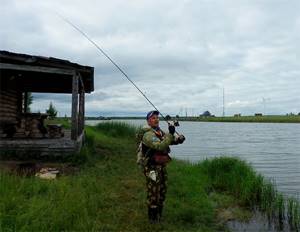
The side cast rightfully occupies the second most common place after the vertical classic. Many fishermen consider it a champion in range, and ultralight lovers use it almost more often than the “vertical”. And this is natural: when casting from the side, only one hand is involved, which is acceptable for light tackle, but you can’t really use a heavy spinning rod in this way.
This method allows you to successfully fish under overhanging trees. The working hand is moved to the side, the rod is directed to the side/slightly upward, and with a sharp movement, without pause, it is brought forward into the working position. When casting horizontally, a large overhang of the bait is usually set (up to a meter), but this parameter, as in the previous case, depends on the desired distance of delivery of the bait and the physiology of the fisherman.
Underhand aiming
This option is optimal in conditions of limited space. It is rational to use it in small or very overgrown reservoirs, as well as when fishing from a boat. Its difficulty can be assessed as average: not for a green beginner, but it does not require sophisticated professionalism.
When two spinning players are positioned close to each other, you probably can’t think of a better option, since casting from under the hand does not require much space for the swing, and the risk of getting caught is minimal.
The movement algorithm looks like this:
- We position the rod horizontally towards the selected landing point of the bait. We set the overhang of the bait to about 40-50 cm.
- With an energetic movement, we move the tip of the form to the side opposite to the working hand, slightly lowering it down. That is, the swing goes first towards the auxiliary hand.
- Return the form to a horizontal position using a reverse motion. We release the fixing finger when the rod is brought into working position.
This method allows you to place the bait with maximum precision, but does not have a high range.
Over the shoulder
The over-the-shoulder method can easily be called forceful: the load on the tackle is very serious, so the parameters of matching the equipment to the casting of the rod are critical. Over-the-shoulder casting is performed with either one or two hands, but it is more suitable for heavy spinning rods intended for trophy fishing. Therefore, it is performed less often with one hand: the auxiliary hand is located on the handle below the reel seat.
Usually the overhang of the bait is small - 15-20 cm, otherwise, if you lack experience, you can catch yourself by the ear. The spinning rod is pulled back, over the shoulder from above. The bait is located at a distance of about 30 cm from the ground. This is followed by a sharp forward swing, and the line must be released at the moment when the tip of the form is directed upward. The bait usually flies far, but aiming will have to be improved through training.
With two hands behind the head
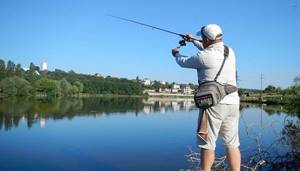
Another definitely power cast, most relevant for heavy-class gear. It is indispensable for delivering heavy pike wobblers and spinners over long distances. An overhead throw is always performed with two bent arms. It requires a large amount of space behind your back, but bushes and trees can grow on the sides almost right next to each other - they will not interfere.
The form is energetically wound behind the head on half-bent arms and sharply sent forward. The fixing finger is released immediately after the tip of the spinning rod crosses the highest point.
Pendulum
We’re done with force methods, let’s move on to options that require special equipment. These include the “pendulum”, highly respected by professional spinning anglers, which allows you to send the bait precisely into the densest support. After mastering it, you can fish complex “windows” surrounded by vegetation, deliver the bait close to snags and thickets - that is, to places where a predator is most likely to stand. We are not talking about significant distances here, but the aiming is truly premium.
You can throw bait of any class with a pendulum, but the heavier they are, the greater the distance you can achieve, and an experienced angler can go beyond the spinning test (the load on the blank is small).
You need to proceed as follows:
- We install a medium (30-40 cm) overhang, open the line holder, and fix the line with your finger.
- Holding the rod in front of you, we seem to swing the bait towards you, performing a downward movement.
- With a sharp movement we send the bait forward, release the line, releasing our finger.
Catapult
We have before us another interesting technique, which apparently came into spinning fishing from fly fishing or from float fishing (features of both options are observed). Catapult casting is very difficult to perform and requires considerable skill from the angler. It is quite unpredictable, does not have a long range, but allows you to fish in the most cramped conditions.
This cast is the only one where the bait is held by the angler’s auxiliary hand, and you need to contrive to take it in such a way as not to get caught on the hook during the take-off phase. That is, you need excellent coordination, which is developed only through long training. The angler takes the wobbler or spoon in his auxiliary hand, pulling the line so that the blank bends slightly. Then he moves the rod slightly upward, while simultaneously releasing the bait, which rushes forward due to the springy properties of the blank. The softer the spinning rod, the less likely it is to break.
What types of casts are there?
To deliver spinning bait to a specific point, anglers use several types. The main ones include:
- vertical;
- horizontal;
- pendulum;
- two hands;
- from under the hand;
- two hands over the head;
- over shoulder.
To be able to fish in any conditions, a beginner must learn all the species. Only such a thorough approach will help you reach fish sites both on a small, overgrown river and in a vast area of lakes and reservoirs.
Vertical, aka classic
On large and medium-sized reservoirs, the banks of which are free of dense vegetation, in most cases you can use the classic or, as it is also called, “vertical” type of casting.
Holding the spinning rod in a vertical position, the angler pulls its tip back and sends the bait to the intended point with a powerful send. This method has several advantages:
- ease of implementation;
- quite high accuracy;
- range.
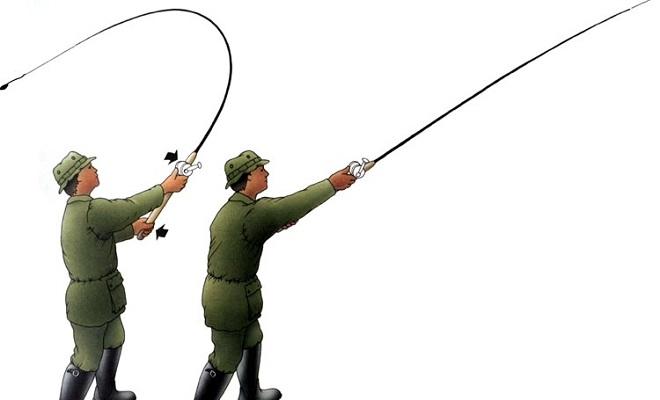
The disadvantages include the mandatory presence of free space behind the fisherman's back. If the bank is overgrown with trees, performing a classic cast will be problematic. This type will also be ineffective in the case when a spinner or wobbler needs to be sent under a bush hanging over the pool. Since the bait flies high when performing a vertical send, you should pay attention to power lines that may pass over the water.
Holding the form with both hands
To increase the vertical casting distance you will need to use two hands. The right hand should be located in the area of the reel seat (if the person is right-handed), and the left hand should be at the bottom of the handle.
When performing a throw, the right hand moves forward slightly. Left - sharply pulled towards the body. This type is a power type, so there is an increased load on the tackle. To avoid breaking the spinning rod, do not wind the monofilament in such a way that it extends beyond the top edge of the spool. Otherwise, the cord will get tangled and stuck in the guide rings.
There are several other factors to take into account:
- the diameter of the guide rings is too small and the weight of the bait is insufficient, which will not allow you to cast it over a long distance;
- the use of an excessively thick fishing line greatly reduces not only the casting distance, but also the accuracy of casting;
- The winding of the monofilament should initially be tight and uniform.
When fishing on a river, you must first estimate the speed of the stream and understand which trajectory the bait will take, and only then cast it.
Horizontal or side
Having mastered the horizontal or side casting method, the fisherman will be able to fish in places where tree branches hang over his head. When using this method, the bait flies low above the water, so it is not difficult to send it under the opposite bank, densely overgrown with bushes.
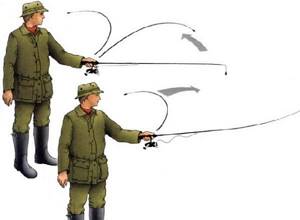
The sequence of actions remains the same as when performing a classic throw. The only difference is that the rod is located in a horizontal plane. For a beginning spinning player, the main problem is the timely removal of the index finger, which fixes the monofilament. If you hurry or delay with this action, the bait will fly in the wrong direction.
Underhand throw
Throwing from under the hand is more often used in small bodies of water, when the bait needs to be placed in a certain place:
- window in aquatic vegetation;
- under an overhanging bush;
- next to a snag or fallen tree.
They also throw from under the arm in cases where space is limited behind and on the sides. The bait falls on the water with virtually no splash and does not scare wary fish. The process is divided into several stages:
- the line is released from the reel until the distance from the tip of the rod to the bait reaches 50 cm;
- the spinning rod is retracted back and down;
- the tackle is fed forward and upward.
The fishing line or cord is released at the moment when the spinning rod takes a horizontal position when fed forward. With certain skills, in this way you can very quickly catch the most promising points on the reservoir.
Pendulum for difficult areas
The pendulum type of casting is used for fishing in very cramped conditions, when it is impossible to make even a small swing. It works like this:
- the bait is lowered 20–30 cm from the tip of the spinning rod;
- the spinner or wobbler is swung;
- When the bait moves towards the selected point, the monofilament is released.
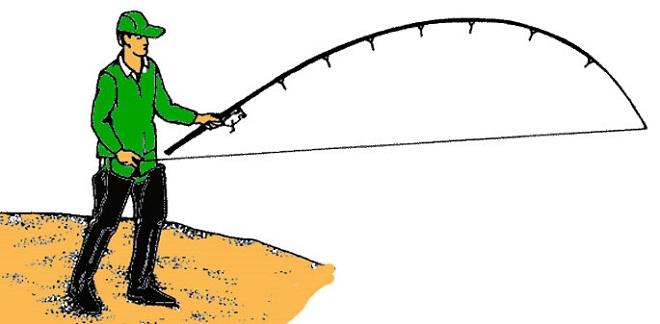
This method is quite complicated and takes a lot of time to master. However, having learned how to make such a cast, the fisherman will be able to fish in the most “strong” places, where large predators most often stand.
Two hands over your head
Throwing with two hands over the head is characterized by high accuracy and range of flight of the bait. To complete it you will need:
- place the tackle in front of you on slightly bent arms;
- open the line guide and fix the cord on your index finger;
- in a vertical position, vigorously pull the rod back, while holding it strictly above your head;
- without stopping the movement of the spinning rod, send a force forward.
The index finger releases the monofilament when the rod tip is at the top point. In this method, a large load is placed on the tackle, so the spinning test and the breaking load of the fishing line must correspond to the weight of the bait used. Otherwise, the likelihood of gear failure will be very high.
Bringing the spinning rod over your shoulder
If there are bushes or trees on both sides of the angler, and there is free space behind him, it makes sense to use an over-the-shoulder cast. To implement it you will need:
- take the tackle in such a way that the left hand is fixed at the end of the handle, and the right hand lies on the reel seat;
- move the rod back until the bait is 20–40 cm from the ground;
- make a sharp movement with the spinning rod in the direction of casting;
- release the line when the tackle is in a vertical position.
After the finger stops fixing the monofilament, the “stick” needs to be lowered down a little. This will reduce the friction of the fishing line on the guides and increase the casting distance.
Casting a spinning rod from a boat
Theoretically, you can cast tackle from a boat in the same way as from the shore, but only if the angler is alone in the boat. If there are two spinners, you need to take care not only of your own comfort, but also the safety of your neighbor. The side cast and the underhand method are definitely safer than the vertical and all options due to the shoulder, head, and so on. You just need to make sure that the hooks do not get caught on the side of the boat.
However, it must be taken into account that the boat is used primarily to gain access to promising places in support, thickets, and so on, so it is not the range that comes to the fore, but the aiming. Therefore, in such cases, spinning anglers usually use pendulum or catapult options.
Mistakes of novice fishermen
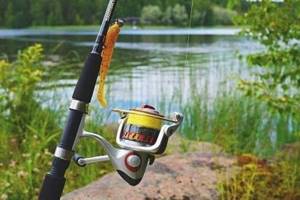
Attentiveness and patience are necessary for the fisherman when fishing with a spinning rod, first of all, constant training is also encouraged. Many beginners want to quickly go fishing with a spinning rod. But they very often make mistakes, the most common of which are:
- Full horizontal position of the rod, which prevents the free passage of fishing line through the winding rings;
- Throwing a spinning rod from behind the shoulder in a horizontal position. Some also have the bait almost lying on the ground. Then the fisherman takes aim and, with a sharp jerk, casts the bait. This way you can easily catch yourself by the head;
- Some throw the spinning rod completely, then shift it to the left hand, and then pull it forward. This way you will not be able to control the bait and your casting distance will suffer greatly.
Choosing the appropriate casting technique is one of the main factors in successful spinning fishing. But if you wish, you can easily hone your skills and you will be able to fish in any conditions and with any gear.
Features of gear with a multiplier
For regular spinning fishing, there is no need for a multiplier - it is needed only for catching very large specimens using heavy tackle. A decent baitcasting reel is expensive, weighs a lot, and if mishandled, will instantly create beards. In general, the animator is for the pros.
The main casting methods are, as in the case of inertia-free casting, lateral and vertical. However, the reel, like the spinning rings, are positioned upward, and the casting should be smoother and more technically refined. Some experienced fishermen even dismantle the line guide and loosen the line as much as possible, which allows them to achieve truly fantastic distances. Most gear with a multiplier requires the need to transfer it to the other hand immediately after splashing down the wobbler or spinner.
Correct casting
Casting is the basis of spinning fishing. But it’s not enough just to be able to send bait from the shore into the water. A real spinning angler must be able to throw the bait to the desired distance and to a specific point with a minimum error.
The effectiveness of fishing often depends on the ability to accurately cast. If you can throw the bait directly under a bush, snag, or clearly under the opposite bank of the river, then your chances of catching a predator increase, and the chance of getting caught and breaking the tackle due to an inaccurate throw decreases.
In this article, the site catcher.fish will tell you how to cast a spinning rod correctly, how to achieve a long cast, and also how to learn how to throw a spinning rod exactly at the target. All this will certainly have to be honed in practice, but without theoretical knowledge, learning how to make correct casts with a spinning rod will be much more difficult. If you know the basics, you will adapt very quickly and be excellent at using spinning tackle, easily making casts to any point in the reservoir where you think a predator should be.
Bait position
In most cases, the bait is positioned freely (only with the ejection version it is clamped by hand). The classic overhang value (that is, the length of the fishing line from the “tulip” of the spinning rod) is 30-40 cm, but it can be increased or decreased depending on some factors:
- type of casting,
- characteristics of the form,
- flight qualities of the bait,
- wind conditions,
- individual preferences of the fisherman.
There is a single rule: the greater the overhang, the further the bait will fly. However, due to this, accuracy will suffer, and the comfort of fishing will leave much to be desired.
Reducing the overhang reduces the load on the blank, which is important when using baits that go beyond the test characteristics of the rod. In addition, the targeting of bait splashdown increases.
Pendulum and catapult casting
In situations where the casting range is short and accuracy is critical, you can use pendulum or catapult casting. The technique for performing them is similar to casting a regular fly fishing rod. This casting technique allows you to fish in the most cramped conditions - on shores overgrown with bushes or among a wall of reeds. This technique is also used when fishing from a boat in the windows of water lily thickets.
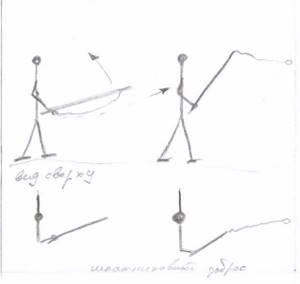
The pendulum throw can be done in a straight line, or it can be done a little to the right or a little to the left
How to perform a pendulum cast
Pendulum casting is carried out due to the inertia of the bait. To cast, the hanging line should be slightly longer than the length of the rod. Holding the bait in your left hand, swing your right hand forward and upward while releasing the bait. The line is released the moment the bait pulls it forward.
This casting can also be done by simply swinging the bait like a pendulum and releasing the line at the right moment.
How to make a catapult cast
Catapult casting is in many ways similar to pendulum casting, but its range is increased by using the elastic properties of the fishing rod. The hanging line is made slightly smaller and, after pulling the bait, the tip of the rod is bent. Of course, it is important not to overdo it and not break the spinning rod in pursuit of casting range.
Casting is carried out similarly to the previous option, sending the rod forward and upward and releasing the bait. At the same time, the rod, straightening, will give the bait an additional impulse, like a catapult. This is precisely the reason for its name.
Correct fixation of the fishing line
When throwing the spinning rod, the line handler's bow opens, that is, without additional fixation, the cord or monofilament will come off the spool freely. Therefore, in the first phases of the movement, you have to use the finger of your working hand in order to somehow fix the line.
On the other hand, you need to be prepared to remove it at the moment of the “shot”, otherwise the flight range will be reduced. Moreover, when using heavy equipment, the risks of injury are high: monofilament cuts fingers especially well, but even with a cord in this situation there is little pleasure. Therefore, we repeat the recommendation: at least during the training stage, put a glove on your working hand.
Some spinners press the line tightly against the side of the spool in the first phase of casting, but this method can be considered the most risky. Therefore, we recommend fixing the fishing line near the rod, without pressing it tightly, but only holding it with your finger. When you “shoot”, you just need to straighten your finger in a timely manner - and the line will be released, the bait will fly in the right direction.
From under your hands
How to learn to throw a spinning rod from this position? This method is suitable for close casts, when vegetation predominates in the coastal zone, when you need to make a short and accurate cast. In general, it is also used for cramped positions, for example, when two fishermen are sitting back to back in a boat. To equip the fishing rod, you need closed-type, inertia-free reels.
How to cast a spinning rod with a spinning reel from under your hand? The rod needs to be pulled out in front of you in an almost horizontal position. We perform the action with one (working) hand. We tilt the top of the gear down. We direct it towards us, then raise the rod so that the stick takes its horizontal position. And we release our finger from the spool - now the bait is in free fall.

How to cast as accurately as possible
Oh, how nice it would be if the fish frolicked in free water, away from snags and thickets! But, unfortunately, it does not think about the convenience of the fisherman, so it usually stands in the most inaccessible places, where there is a high risk of snagging the gear. For example, when hunting for a passive summer pike, you need to deliver the bait right under the nose of the predator sitting in a secluded corner of the reservoir.
It is clear that the greater the distance, the less targeted the throw. The optimal option for balancing range and accuracy is vertical casting, but only with sufficient experience of the spinning angler. At short distances, the “underhand” and “pendulum” methods allow you to put the bait directly into the bull’s eye.
In all cases, one should not forget about the filigree adjustment of the tackle and the installation of a small (15-20 cm) overhang.
How to make the longest cast
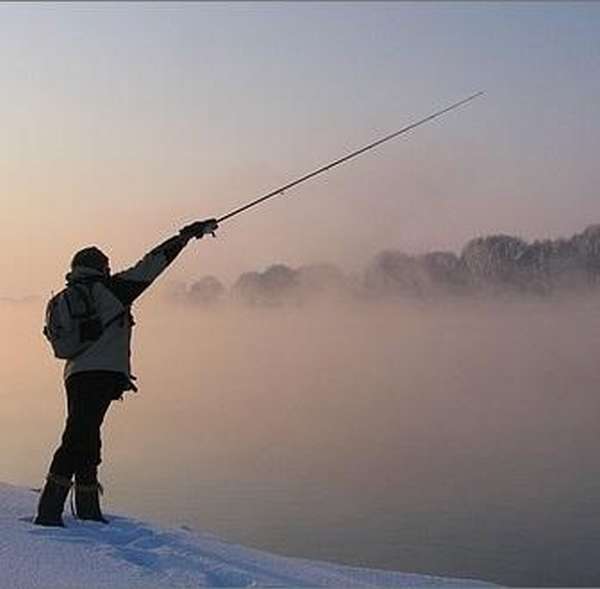
The concept of casting range of a spinning rod is a combination of two factors of gear and type of casting. As mentioned above, a vertical cast allows you to send the rig the farthest, but in tandem with a long rod blank this is even much easier to do. Important! The farthest sends of baits allow fishing rods over three meters, fast or semi-fast action.
Consequently, the casting distance depends on the type of swing and the length of the tackle. When considering how the long-distance casting technique is carried out, you need to build on the classics of vertical casting, only in addition to this technique is putting the greatest force into the swing.
Important! In cramped throwing conditions, it is impossible to achieve the longest cast possible. Difficult conditions include headwinds or crosswinds and the presence of obstacles that prevent the maximum swing at the service point.
What affects range
There are many factors influencing the flight range of a bait. Among them it is worth noting:
- Type of casting . It is clear that with a forceful version, for example, from behind the head, the distance will be higher.
- Bait characteristics . In this case, not only the mass of the wobbler, spoon or jig head is taken into account, but also the aerodynamic properties.
- Test and build the rod . Slow action blanks are theoretically longer-range. With an ultralight you can send the bait further than with a heavy rod.
- Wind conditions . This point is especially critical when “throwing” light baits. You should also pay attention to the thickness of the fishing line: the thicker it is, the higher the windage and drift angle.
- Fisherman's persona . Both the physical condition and technique of the spinning player matter.
Long-distance spinning casting technique
All the same, sooner or later you will have to learn how to throw a spinning rod over long distances. Here you will need to prepare your gear and work on your technique. With the gear, everything is quite simple: take a longer spinning rod, wind more fishing line on the reel and set the bait of the maximum weight. But you can cast a spinning rod long distance with other parameters.

- The structure of the spinning rod greatly influences the casting distance. Its length also plays an important role. A spinning rod with a slow action allows you to achieve maximum casting distance for bait.
- The diameter of the fishing line is also a very important parameter. The thinner it is, the farther you can cast baits. Moreover, very often a difference of even a few millimeters is noticed.
- The design features and weight of the bait also make their own adjustments to the casting efficiency.
If your tackle does not meet the requirements, then you will not be able to cast far. Even if you perfect your technique and practice for a long time. The combination of technique and gear is important here.
Common mistakes
We have already mentioned most of the typical mistakes; all that remains is to systematize them:
- Manipulations with the line laying machine . In the initial phase, the line guide must be open. This must be brought to automaticity, otherwise during power casts you can part with the bait due to a broken line, and in the worst case, break the spinning rod. After splashing down the bait, it is better to manually close the bow, without waiting for automatic operation when winding - this will make the reel last longer.
- Rod control . The fisherman must clearly understand what this or that manipulation will lead to. In the final phase, the rod should be positioned horizontally, at a slight angle to the direction of the line (depending on the current and wind conditions). No need to lift it up or try to position it exactly “on line”!
- Hooking the equipment to the “tulip” . When fishing for pike, a mandatory element of the equipment is a leash (metal, Kevlar, fluorocarbon twist, and so on). In its absence, the predator will instantly bite the fishing line. Sometimes, in the heat of the moment or due to inexperience, the leash is wound close to the last ring of the spinning rod or even passed through it. The result is a line break, premature wear of the ring and other “delights”.
- Hand position . Remember that the leg of the reel seat should be located between the index and middle fingers of the working hand. The fishing line is fixed (slightly pressed) with the index finger. It must straighten clearly at the moment of the “shot”, otherwise the bait will go up, will not fly far forward, and the fishing line will most likely get tangled. Let go late - the distance will be reduced, and you can damage your finger.
- Casting technique . The spinning rod is thrown in one movement, without fixing at the end points of the trajectory: we pull it back and immediately send it forward. There is no need to freeze in an extreme position: the message should be a single whole.
Power casting technique
Power casting a spinning rod is technically difficult. Not every angler masters it fully even after many years of experience in spinning fishing. The most common methods where throwing range is important are:
- shore jig;
- diverter leash;
- asp hunting.
Advice! It’s best to learn how to force cast from seasoned shere fishermen, for whom casting far is vital in order to catch a cautious sheresper.
Features of fishing with a spinning rod on a retractable leash
Having mastered the correct power casting technique, a spinning angler can fish remote promising areas at a distance of 100 meters or more. To make the longest cast, you must follow the following rules:
- The bait should hang down 2/3 of the rod length;
- The left hand is positioned as low as possible on the handle to give maximum force at the time of casting;
- The swing is performed smoothly, the bait is brought behind the back in an arc;
- The throw itself is carried out with acceleration;
- The bait should fly out at an angle of about 45 degrees to the surface;
- The rod is held so that it forms a straight line with the flying line to minimize friction;
- The line-laying arm is snapped into place the moment the bait touches the water.
Naturally, every angler throws differently. Some people send the bait from behind their heads, while others are more comfortable casting from the side. But the general rules remain the same. It is necessary to minimize friction and give the equipment maximum momentum, sending it at the optimal angle to the horizontal plane.
Tips for beginners
At the end of this post, let me give you some advice:
- Train in optimal conditions. You won’t be able to fish accurately right away, because the fish usually stands in hard-to-reach places where there is a high risk of getting caught. Go to a large body of water with minimal wind, throw the bait at a selected point in the free water. At the same time you will work out the wiring.
- Use other people's experience. No descriptions, photos or videos can replace real mentoring. It is ideal if during your first trips you will be accompanied by an experienced technician who will help you install the equipment and prevent critical mistakes.
- Don't go beyond the rod's specifications. At first, select equipment elements exclusively within the framework of the form test. Later, when you become a pro, you will be able to throw heavier baits with ultralights. And at first do not take forms longer than 2.1-2.4 meters, even when fishing from the shore.
Good luck to you, beginning spinners! Fewer annoying snags, more enviable trophies and incredibly adrenaline-pumping experiences!
Fishermen wonder why I’m biting and they’re not?
I’m revealing a secret just for you: it’s all about the miracle bait! More details
Horizontal (side) cast
In situations where the situation does not allow for a vertical cast, for example, there is an obstacle behind you or the crown of a tree hangs low over your head, a side cast is used, which is carried out in a horizontal plane. If we compare side casting with vertical casting, we can say that it is usually inferior in range and, especially, accuracy.
Read more
What is a jig?
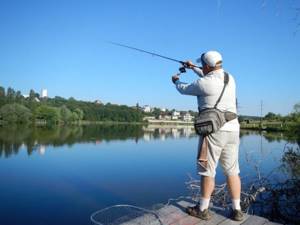
It also has negative sides - it is not entirely accurate, not as accurate as we would like
How to perform the horizontal casting technique
In many ways, the technique of performing horizontal casting is similar to vertical casting. To perform a side cast, you must :
- ensure that the bait hangs about 30 cm from the tip of the rod;
- Having first hooked the line with your index finger, open the line guide;
- move the rod to the side, making sure that there are no obstacles in its path of movement;
- cast with a quick movement, stopping the movement of the rod in the direction of the casting point;
- the line is released when the rod has 40-50ᵒ left to go to the finishing position;
- after the bait falls into the water, the line layer is returned to its working position and the resulting arc is selected from the fishing line.
It’s easy to adjust the moment of line release based on the deviation of the bait’s fall from the aiming point. If the bait fell to the left, the line must be released earlier, if it fell to the right, later.
To increase the casting distance, you can cast it not strictly horizontally, but slightly upward.
Basic mistakes when casting a spinning rod
When making casts, mistakes are often encountered in their technique. They are especially common among beginners who are just starting to master spinning fishing.
Let's try to look at the most common of them:
- an attempt to cast without opening the line guide most often leads to “shooting” of the bait, and sometimes to breaking the rod tip;
- The line arc is closed by turning the reel handle rather than by hand. This action leads to premature failure of the reel, namely frequent arbitrary closing of the line guide during casting;
- During casting, the line is pressed with your finger against the rod blank, which does not allow you to easily remove it from your fingertip. Leads to a delay in line release and, as a consequence, a reduction in casting distance;
- During casting, the angler puts in all his strength, even if it is not necessary. This leads to rapid fatigue, and casting accuracy suffers.
In order to avoid these and other mistakes, you can film your casting technique and compare it with a standard, for which you can choose one of the leading spinning players.
Originally posted 2018-05-16 10:00:38.


